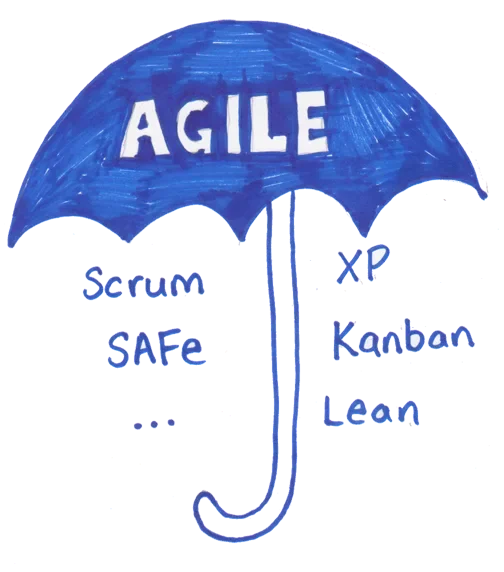Agile Is the New Yoga
I love capitalism, truly. One of my favorite aspects of it is the very idea of a competitive marketplace that, ideally, operates largely on reputation, merit and provided value.
Unfortunately, the competition inherent in a free market can result in obscuring principles and values in favor of flashy marketing and unmet promises. This is especially true when a popular concept becomes so entrenched in the zeitgeist that people line up for miles to co-opt it.
Yoga survived thousands of years before it happened. With Agile, we at least waited a couple decades.
Once a proven set of ideas or practices become popular enough in the mainstream, a few things happen.
We feel an overwhelming tribal urge to belong, and it becomes incredibly important to identify as one of the enlightened.
Industrious companies and individuals figure out a way to package and sell us that identity.
After purchasing our membership to the Cool Kids Club, we remember that actual growth and transformation comes through continuous, focused (yet remarkably simple) efforts.
This is the end of our first act, after which we choose one of three paths:
A) Approximately 36%** of us give up immediately, admitting defeat.
B) 61% pretend we “walk the talk” while actually phoning it in. We might even sincerely believe we’re legit because, hey, we have that certification and a closet full of spandex.
C) 3% of us — over time — become true believers and practitioners through principled application and continued study.
(** source: “the internet”)
There are, of course, a couple other peculiar (yet predictable) things you might notice.
The first is that the release of every new brand or flavor promises better results with even less effort. If it’s not Power Yoga, Hot Yoga, Acro Yoga and Goat Yoga it’s XP, Scrum, Kanban, Lean, SAFe, Scrumban and LeSS.
The other is a little less obvious. The vast majority of people committed to continual improvement in their discipline are not the ones sermonizing its virtues nor denouncing it as snake oil. They might advocate a position, but most of the time they’re too busy doing the work.
One Ring to Rule Them All?
Now, to reiterate: I don’t blame the commercialization nor any of the people involved. This is not a rant against commercialization at all. Money and I are in a committed, long-term relationship.
The point is: Yes, there is a ton of power in variety and competition, but buyer beware when it comes to brand loyalty. There be dragons.
The big problem with the proliferation of brands and frameworks isn’t that they’re illegitimate expressions of the practice, either. It’s that, even in a marketplace of ideas, we’re conditioned to seek the one clear winner, and fans will swear to you that their particular brand is the brand. XP is a viable flavor of Agility. Its viability does not delegitimize nor devalue Scrum as — you guessed it — a viable flavor of Agility.
In fact, the most effective agile development shops recognize that every single one of the above schools provide value. It’s why the good shops steal, pillage and borrow ideas from everywhere.
It’s typically when a person tells you they are “pure XP” or “100% Scrum” that you should raise an eyebrow, snicker, laugh out loud, or commit to the full eye-roll. If the person telling you that just hired you … Run?
Staying loyal to your brand, refusing to try something on the basis it’s “from that other playbook” makes for a bad coach and a stale team, composed of people who will tolerate bad coaching and poor performance.
(Side note: There’s rich, smirk-inducing irony to be found in defending strict process implementation … that descends from a philosophical belief to literally “Value Individuals and Interactions over Processes and Tools”)
Practice?? We’re Talking About Practice?!?
Early failures from the “pretender” group typically come with excuses that seem reasonable enough on the surface.
“We did daily standups. They weren’t valuable.”
Is it possible you gave up too quickly? Maybe you half-assed the effort? Or perhaps, in forgetting the value prop of a daily scrum, you simply did it WRONG?
“We never hit sprint commitments, so we gave up. I mean sure, unplanned & unexpected tasks magically appeared on the board literally every sprint. But all those tasks were important … SO important, in fact, that we couldn’t pull anything else off the board.”
Failure to focus, commit, negotiate and execute has to be the absolute worst reason to abandon focus and commitment.
You can hold lazy “standups” in Slack, blow up every sprint with the newest top priority, sleepwalk through retrospectives and claim agile just doesn’t work for you. I hear ya. I spend 3 hours per week in child’s pose, and I still can’t touch my toes! Clearly it’s the yoga that’s wrong. Buncha bogus Balasana bullsh…
And while courses and certifications certainly can be valuable, don’t mistake them as replacements for actual experience. Will a weekend Scrum workshop make you an Agility Expert™? Do $150 yoga pants actually give you Jessica Alba’s rear view?
Joking aside (but within arm’s reach) the whole reason this fun little Agile<>Yoga analogy took hold in the first place is precisely because both are widely regarded as a practice. What that means is that progress is the goal.
That’s it. Just get better.
You never cross a finish line, defeat the final boss or beat the game (though a final boss fight would be so cool). Sure, your competence and confidence grows over time, and you develop increasing levels of mastery, but you’re never “done” with Agile unless you quit. It’s a martial art (ooh, bonus analogy!)
Remember Our “Why”
We as Software Professionals owe ourselves and each other an honest (and maybe painful) assessment of our efforts. We could continue to sit around and debate the merits of LeSS vs SAFe, common pitfalls of Kanban or how XP lost its sex appeal, OR we could sincerely ask ourselves and our peers how well we prioritize
Individuals and Interactions over Processes and Tools
Working Software over Comprehensive Documentation
Customer Collaboration over Contract Negotiation
Responding to Change over Following a Plan
If effectively delivering great software to our customers is the goal, and why we started driving down this road in the first place, then I’d prefer to focus on optimizing the engine under the hood. I can borrow tools from anyone.


